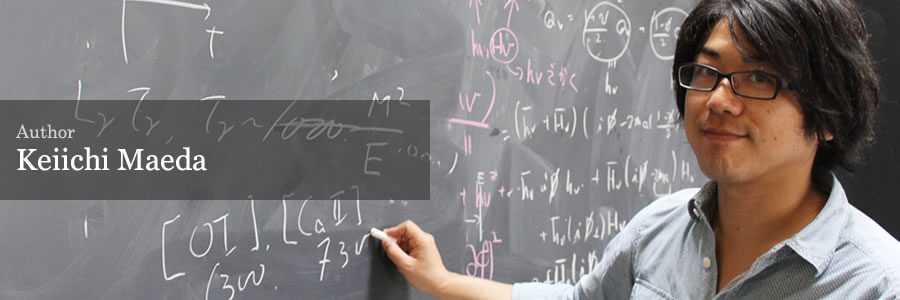What would you like to introduce to readers in this series?
Amazement, and Assent. This is my impression when I looked at the late-time spectrum of Supernova 2005cz observed by Dr. Kawabata with the Subaru Telescope. We had not understood anything about the identity of this "peculiar" supernova, but I thought I had found a key to answering this question at last.
After more than half a year has passed following a supernova explosion, it becomes "spongy" (less dense) with the expansion of the explosion, and the spectrum is very important for the clarification of parent star and explosion mechanism. I released several papers of theoretical research devoted to this topic, and collaborated with Dr. Kawabata and others to advance the "unique" (difficult) observation that is spectroscopic observation of the darkened "late-time" supernova using the Subaru Telescope, and we got many interesting results. Supernova 2005cz is one of the highlights of these results. Nowadays, similar supernova are found, and international research has advanced, revealing these as "intense calcium" (Ca-rich) Supernova. Without the Subaru Telescope observation, this type of supernova would not attract so much attention.
In this story, I would like to explain how research progresses while theory and observation are intertwined. It is like this: a new method of observation consists of the theoretical prediction (late-time spectroscopic observation). The observation provides data that resembles the outside of the previous theoretical data (specificity of oxygen / calcium emission line). Then actually, the data is able to explain reasonably when going back to the theoretical basics (evolution of a comparatively low-mass star).
At the same time, I would like to convey the real thrill of astronomy in which only the various observations will lead to new discoveries.
My research field and current interests:
I have advanced the research of supernovae both theoretically and observationally with various wavelengths and methods. I want to figure out how a supernova forms and distributes elements/dust particles/cosmic rays to the Universe, while I have advanced the research of the parent star, explosion mechanism and their relationship in a supernova that still presents many mysteries.
Now, I am deep in observational research and continuing to advance theoretical research for the reasons of the excitement about research into Supernova 2005cz and instruction by Dr. Kawabata and other professionals of observation. Using the Subaru Telescope, the late-time spectroscopic observation in visible and near-infrared wavelength is mainly advancing in Type Ia Supernova. With these advances, we try to figure out the parent star and supernova explosion mechanism of Type Ia Supernova, and then we want to find out the properties of the "standard light source" that is used for cosmology. Also in the near-infrared, we can approach the existence of elements and dust particles that are not seen in visible light.
Recently, I have worked to advance the theoretical research in radio wavelength, X-rays, and gamma rays. I devised several observational ideas for finding out what the process of forming elements and cosmic rays is in the supernova explosion. And now, I have just started to present proposals to observe a supernova and supernova remnant in the range of low/high wavelength. Luckily, the proposals have been adopted at ALMA Telescope, etc. After this, I would like to understand the properties of supernova comprehensively from observations in various wavelengths.
Data
- Name
- Keiichi Maeda
- Affiliation
- Department of Astronomy, Kyoto University
- Job Title
- Associate Professor
- Field of Expertise
- Theoretical and Observational Astronomy
